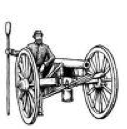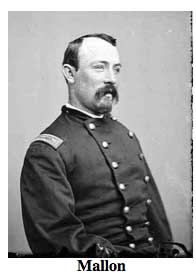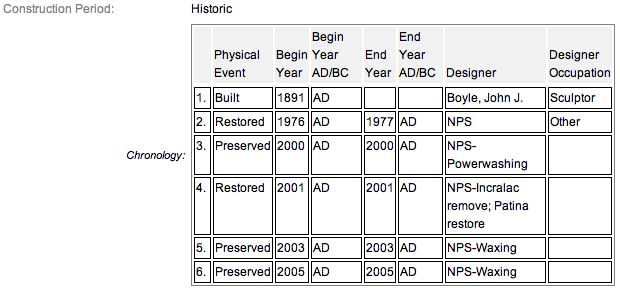
The 42nd New York Infantry was also known as the Tammany Hall Regiment. During the battle of Gettysburg, it served as a member of Hall’s Brigade in Gibbon’s Division of the Second Corps, Army of the Potomac, a Fighting 300 Regiment. This regiment was organized by the “Tammany General Committee,” (hence its name) under the patronage of the Tammany Society of New York City. It was mustered in June 22, 1861, and on the 18th of July, following, went to Washington, 1,019 strong. All totaled, the 42nd New York Infantry Regiment lost 11 officers and 141 enlisted men killed and mortally wounded and 1 officer and 103 enlisted men to disease during the Civil War. The 42nd New York Infantry was commanded by Colonel James E. Mallon (1836-1863). Mallon was killed in action at Bristoe Station, Wed-
nesday, Oct. 14, 1863. He was of Irish-American parentage, and born in the City of Brooklyn, Sept. 12, 1836. Prior to the war, Mallon was in the wholesale commission business in New York City. The regiment under Colonel Mallon brought 197 men to the field, and among them 15 men were killed, 55 wounded and 4 went missing.
The 42nd New York Infantry Monument is located on the right or east side of  Hancock Avenue (RD310) if traveling north along the road at an area called The Angle. The monument is 181 feet southeast of the
Hancock Avenue (RD310) if traveling north along the road at an area called The Angle. The monument is 181 feet southeast of the  High Water Mark of the Rebellion Monument (MN230). On this side of the road and across the road, there are about 1080 feet of green fields with a line of monumentation spread across it representing the line of union regiments who defended Cemetery Ridge at The Angle against Longstreet's assault also referred to as Pickett's Charge on July 3, 1863, the final day of the Great Battle.
High Water Mark of the Rebellion Monument (MN230). On this side of the road and across the road, there are about 1080 feet of green fields with a line of monumentation spread across it representing the line of union regiments who defended Cemetery Ridge at The Angle against Longstreet's assault also referred to as Pickett's Charge on July 3, 1863, the final day of the Great Battle.  Parking is plentiful and is available road-side at intermittently enlarged shoulder cut-outs, usually marked with white striping. Be sure to keep vehicles off the grass or you will be ticketed by park police. I visited this monument on Tuesday, August 7, 2012 at approximately 4:27 P.M. I was at an elevation of 593 feet, ASL. I used a Canon PowerShot 14.1 Megapixel, SX210 IS digital camera for the photos.
Parking is plentiful and is available road-side at intermittently enlarged shoulder cut-outs, usually marked with white striping. Be sure to keep vehicles off the grass or you will be ticketed by park police. I visited this monument on Tuesday, August 7, 2012 at approximately 4:27 P.M. I was at an elevation of 593 feet, ASL. I used a Canon PowerShot 14.1 Megapixel, SX210 IS digital camera for the photos.
The Draw the Sword site helped out by the NPS narrative and the SIRIS site offers the following description: A portrait of Native-American Chief Tammany standing in front of a teepee at the top of an elaborate granite base adorned with bronze plaques. The lower part of the shaft has excised polished letters and the upper part has a polished face with excised letters, bronze medallion, and three bronze tablets. It cost $8,500. It stands at nearly 28' in total height. The monument is topped by the figure of the Delaware Indian Chief Tammany, because he sided with America during the Revolution and became the symbol for the powerful New York City political hall that raised the regiment.
The monument was dedicated in 1891 by the State of New York. The monument is composed of Quincy granite w/ bronze for the statue and has the following dimensions: The sculpture is 27 feet 10 inches x 12 feet², the statue is 7 feet in height, the teepee is 16 feet by 6 feet and the base is 10 feet in height. The monument was sculpted by John J. Boyle (1851 - 1917) and finished at the Bureau Brothers foundry as were many other monuments at Gettysburg. There are inscriptions on all four sides which read:
 (Front):42nd
(Front):42nd
New York
Infantry.
3rd Brigade,
2nd Division,
2nd Corps.
Tammany
Regiment
(Left):July 2, 1863. Went to
support of 3rd. Corps
about 5 p.m. Held this
position July 3rd, and,
assisted in repulsing
the assault of
Pickett's Division.
Casualties;
Killed 15, wounded 55,
missing 4.
(Back):This regiment was raised
and organized by Colonel
William O. Kennedy under
the patronage of the
Tammany Society and
of the Union Defense
Committee of
New York City.
(Right):Mustered into U.S.
service June 22, 1861.
Total enrollment 1210.
Participated
in 19 battles.
Killed 92.
Wounded 328.
Missing 298.
Mustered out
July 13, 1864.
The 42nd New York Infantry Monument is a contributing feature to the Gettysburg National Military Park Historic District which is nationally significant under NR Criteria A, B, C & D. Areas of Significance: Military, Politics/Government, Landscape Architecture, Conservation, Archeology-Historic. Period of Significance: 1863-1938. The original National Register Nomination was approved by the Keeper March 19, 1975. An update to this nomination was approved by the Keeper on January 23, 2004. The monument is identified as structure number MN244-B.
From the Nomination Form:
1 of 90 New York Monuments. Indicates position held morning July 2, 1863 & July 3, 1863. Located E side Hancock Ave near Copse of Trees. LF&RF markers 99' & 48' N-S of Mn, respectively.
Short Physical Description:
Mn & 2 flank markers. 3 part stepped base, 1st 12'sq. 2 part shaft, 1st: excised polished letters, 2nd: polished face w/ excised letters, bronze medallion, other 3 bronze tablets. Top: bronze statue of Chief Tammany & teepee. All 27'10"H. LF&RF 1'6"x1'1"x1'9"H.
Long Physical Description:
Monument that has two flanking markers. Monument is a two-part granite shaft topped with a bronze statue of Chief Tammany and a teepee and set on a three-part stepped base of which the lowest step is twelve foot square. The lower part of the shaft has excised polished letters and the upper part has a polished face with excised letters, bronze medallion, and three bronze tablets. Overall height 27.10 feet. Sculptured by John J. Boyle. Flanking markers are 1.6x1.1 foot. Located on the east side of Hancock Avenue near the Copse of Trees.

My Sources
1.
NRHP Nomination Form
2.
SIRIS
3.
Stone Sentinels
4.
Virtual Gettysburg
5.
Draw the Sword
6.
Historical Marker Database
7.
New York State Military Museum
8.
Wikipedia